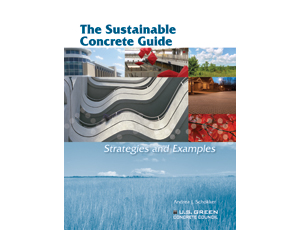A new book coming this spring from the U.S. Green Concrete Council, a for-profit unit of American Concrete Institute, calculates the "green-ness" of the world's most consumed building material.

Produced at a rate of about 25 billion tons per year and growing, concrete requires a tremendous amount of energy to produce, transport, build and maintain, and it contributes to the world's carbon-dioxide emissions. But it also provides benefits. The book weighs and balances the issues to help designers make more efficient use of the material.
"Wise use of this material can make a significant contribution to the achievement of sustainable development," writes Andrea J. Schokker, a professor of civil engineering at University of Michigan-Duluth and author of "The Sustainable Concrete Guide," available this spring for $75.
The roughly 100-page book breaks down common concrete myths and assumptions. For example, it is well known that concrete acts like a solar "battery," trapping heat and slowly emitting it to help offset a building's heating and cooling loads.
However, researchers discovered that concrete walls built beyond the industry's conventional range of 8 in. to 10 in. provide no significant thermal-mass benefit on a 24-hour basis. In other words, thicker is not always better.
"We want to quantify the true benefit, rather than just greenwashing," says Florian Barth, a retired structural engineer and president of ACI, who leads the book's editorial review panel. In the book, concrete's thermal mass is calculated by BTUs of stored heat per sq ft per hour, and it provides design guidelines.
Among other things, the book also addresses the use of high-strength concrete and its impact on the environment. Concrete mixes of high pressure require more portland cement, which raises their carbon footprint. But they use less overall virgin material and take up less space than lower-strength mixes, the book explains.
"I think in the future there will be a push toward more high-strength concrete," notes Barth.
Not addressed in this volume are new types of mix designs and products that may reduce concrete's environmental footprint. But the USGCC plans to release a follow-up volume in the fall that will delve into these newer applications and try to sift through the marketing hype that has become associated with the green movement, researchers say.
The publisher announced the first volume at this year's World of Concrete, held Feb. 2-5 in Las Vegas. Show attendees can order the book on-site for a discount price of $63.


Post a comment to this article
Report Abusive Comment